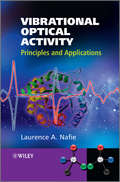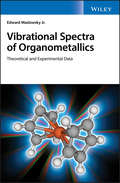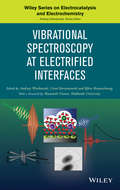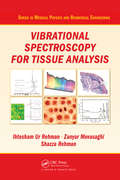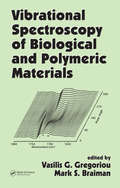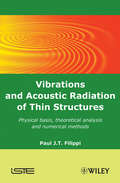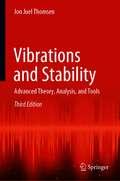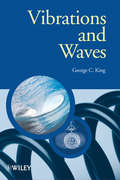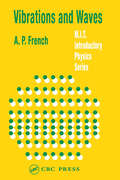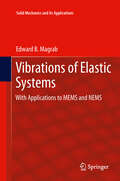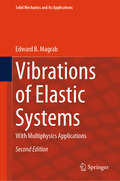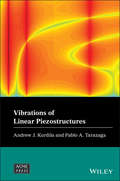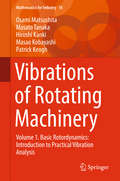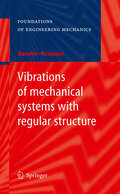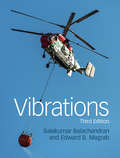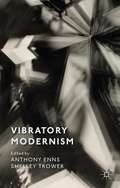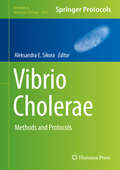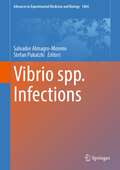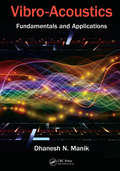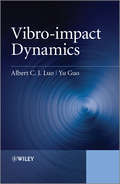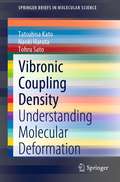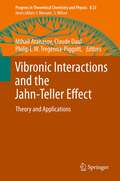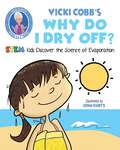- Table View
- List View
Vibrational Optical Activity
by Laurence A. NafieThis unique book stands as the only comprehensive introduction to vibrational optical activity (VOA) and is the first single book that serves as a complete reference for this relatively new, but increasingly important area of molecular spectroscopy.Key features:A single-source reference on this topic that introduces, describes the background and foundation of this area of spectroscopy.Serves as a guide on how to use it to carry out applications with relevant problem solving.Depth and breadth of the subject is presented in a logical, complete and progressive fashion.Although intended as an introductory text, this book provides in depth coverage of this topic relevant to both students and professionals by taking the reader from basic theory through to practical and instrumental approaches.
Vibrational Spectra of Organometallics: Theoretical and Experimental Data
by Edward Maslowsky Jr.A comprehensive compilation of the available experimental and theoretical vibrational data for organometallic compounds and its role in evaluating the structures, bonding, and properties of these key compounds This unique book offers a thorough review of the literature dealing with vibrational data obtained using various phases, including matrices, reported for organometallic compounds from infrared spectra, Raman spectra, and several other techniques. It is the only one that compiles the available experimental and theoretical vibrational data on these compounds, and which discusses the importance of this information and its role in evaluating structures, bonding, and other important properties. It also treats the use of DFT and other theoretical calculations to analyze the vibrational data and to predict properties associated with these compounds. The book also includes vibrational data for organic species that form on metal and other surfaces. Vibrational Spectra of Organometallics: Theoretical and Experimental Data offers complete coverage of: Carbide, Alkylidyne, Alkylidene, Alkyl, and Alkane Derivatives; Noncyclic Carbon Clusters and Unsaturated Hydrocarbon Derivatives; and Cyclic, Unsaturated Organometallic Derivatives. By summarizing work that has already been done on organometallic compounds, it serves as an important reference for those studying their vibrational spectra and will, in the end, lead to a clearer understanding of other research that needs to be done in order to help researchers determine new research directions. An important reference for those studying the vibrational spectra of organometallic compounds Gathers the existing experimental and theoretical vibrational data and discusses its significance in assessing structures, bonding, and other principle properties Includes DFT methods for the interpretation of spectra, which has been one of the major developments of the last two decades Vibrational Spectra of Organometallics: Theoretical and Experimental Data is an important reference for researchers and practitioners in the areas of inorganic, organometallic, organic, and surface chemistry who have an interest in using vibrational data to characterize the bonding, composition, reactions, and structures of organometallic compounds, and organic species that are formed on various surfaces.
Vibrational Spectroscopy at Electrified Interfaces
by Andrzej Wieckowski Carol Korzeniewski Björn BraunschweigReviews the latest theory, techniques, and applicationsSurface vibrational spectroscopy techniques probe the structure and composition of interfaces at the molecular level. Their versatility, coupled with their non-destructive nature, enables in-situ measurements of operating devices and the monitoring of interface-controlled processes under reactive conditions.Vibrational Spectroscopy at Electrified Interfaces explores new and emerging applications of Raman, infrared, and non-linear optical spectroscopy for the study of charged interfaces. The book draws from hundreds of findings reported in the literature over the past decade. It features an internationally respected team of authors and editors, all experts in the field of vibrational spectroscopy at surfaces and interfaces. Content is divided into three parts:Part One, Nonlinear Vibrational Spectroscopy, explores properties of interfacial water, ions, and biomolecules at charged dielectric, metal oxide, and electronically conductive metal catalyst surfaces. In addition to offering plenty of practical examples, the chapters present the latest measurement and instrumental techniques.Part Two, Raman Spectroscopy, sets forth highly sensitive approaches for the detection of biomolecules at solid-liquid interfaces as well as the use of photon depolarization strategies to elucidate molecular orientation at surfaces.Part Three, IRRAS Spectroscopy (including PM-IRRAS), reports on wide-ranging systems-from small fuel molecules at well-defined surfaces to macromolecular complexes-that serve as the building blocks for functional interfaces in devices designed for chemical sensing and electric power generation.The Wiley Series on Electrocatalysis and Electrochemistry is dedicated to reviewing important advances in the field, exploring how these advances affect industry. The series defines what we currently know and can do with our knowledge of electrocatalysis and electrochemistry as well as forecasts where we can expect the field to be in the future.
Vibrational Spectroscopy for Tissue Analysis (Series in Medical Physics and Biomedical Engineering)
by Ihtesham ur Rehman Zanyar Movasaghi Shazza RehmanA rapidly growing field, vibrational spectroscopy has found applications in industries including pharmaceutical manufacture, food and drug safety, and process monitoring on production lines. In particular, interest in clinical spectroscopy is rising rapidly as researchers recognize the potential of the vibrational spectroscopic techniques-Infrared
Vibrational Spectroscopy of Biological and Polymeric Materials
by Vasilis G. Gregoriou Mark S. BraimanUsed primarily for characterizing polymers and biological systems, vibrational spectroscopy continues to uncover structural information pertinent to a growing number of applications. Vibrational Spectroscopy of Biological and Polymeric Materials compiles the latest developments in advanced infrared and Raman spectroscopic techniques that are
Vibrations and Acoustic Radiation of Thin Structures: Physical Basis, Theoretical Analysis and Numerical Methods
by Paul J. FilippiSound is produced by vibrations and as such can be dampened or augmented based on materials selection. This title looks at the effects of sound and vibration on thin structures and details how damage may be avoided, acoustical effects created, and sound levels controlled.
Vibrations and Stability: Advanced Theory, Analysis, and Tools
by Jon Juel ThomsenAn ideal text for students that ties together classical and modern topics of advanced vibration analysis in an interesting and lucid manner. It provides students with a background in elementary vibrations with the tools necessary for understanding and analyzing more complex dynamical phenomena that can be encountered in engineering and scientific practice. It progresses steadily from linear vibration theory over various levels of nonlinearity to bifurcation analysis, global dynamics and chaotic vibrations. It trains the student to analyze simple models, recognize nonlinear phenomena and work with advanced tools such as perturbation analysis and bifurcation analysis. Explaining theory in terms of relevant examples from real systems, this book is user-friendly and meets the increasing interest in non-linear dynamics in mechanical/structural engineering and applied mathematics and physics. This edition includes a new chapter on the useful effects of fast vibrations and many new exercise problems.
Vibrations and Waves
by Benjamin CrowellPart of the Light and Matter series of open source textbooks.
Vibrations and Waves
by George C. KingThis introductory text emphasises physical principles, rather than the mathematics. Each topic begins with a discussion of the physical characteristics of the motion or system. The mathematics is kept as clear as possible, and includes elegant mathematical descriptions where possible. Designed to provide a logical development of the subject, the book is divided into two sections, vibrations followed by waves. A particular feature is the inclusion of many examples, frequently drawn from everyday life, along with more cutting-edge ones. Each chapter includes problems ranging in difficulty from simple to challenging and includes hints for solving problems. Numerous worked examples included throughout the book.
Vibrations and Waves (MIT Introductory Physics Series)
by A.P. FrenchThe M.I.T. Introductory Physics Series is the result of a program of careful study, planning, and development that began in 1960. The Education Research Center at the Massachusetts Institute of Technology (formerly the Science Teaching Center) was established to study the process of instruction, aids thereto, and the learning process itself, with special reference to science teaching at the university level. Generous support from a number of foundations provided the means for assembling and maintaining an experienced staff to co-operate with members of the Institute's Physics Department in the examination, improvement, and development of physics curriculum materials for students planning careers in the sciences. After careful analysis of objectives and the problems involved, preliminary versions of textbooks were prepared, tested through classroom use at M.I.T. and other institutions, re-evaluated, rewritten, and tried again. Only then were the final manuscripts undertaken.
Vibrations of Elastic Systems
by Edward B. MagrabThis work presents a unified approach to the vibrations of elastic systems as applied to MEMS devices, mechanical components, and civil structures. Applications include atomic force microscopes, energy harvesters, and carbon nanotubes and consider such complicating effects as squeeze film damping, viscous fluid loading, in-plane forces, and proof mass interactions with their elastic supports. These effects are analyzed as single degree-of-freedom models and as more realistic elastic structures. The governing equations and boundary conditions for beams, plates, and shells with interior and boundary attachments are derived by applying variational calculus to an expression describing the energy of the system. The advantages of this approach regarding the generation of orthogonal functions and the Rayleigh-Ritz method are demonstrated. A large number of graphs and tables are given to show the impact of various factors on the systems' natural frequencies, mode shapes, and responses.
Vibrations of Elastic Systems: With Multiphysics Applications (Solid Mechanics and Its Applications #184)
by Edward B. MagrabThis book presents new topics such as Inerters in spring-mass models and attached to beams; fluid loading on beams, plates, and shells; bio-inspired vibration isolation and absorption; coupled bending and torsion of beams; beams with functionally graded materials; as well as a new chapter on the Mindlin/Timoshenko plate theory: rectangular and circular. New applications and enhancements to the previous edition include moving mass on beams; thin beams with attached pendulum; transient response of beams with in-span attachments; and shells to model blood flow in arteries.
Vibrations of Linear Piezostructures (Wiley-ASME Press Series)
by Andrew J. Kurdila Pablo A. TarazagaA thorough guide to the fundamental development of linear piezoelectricity for vibrations Vibrations of Linear Piezostructures is an introductory text that offers a concise examination of the general theory of vibrations of linear piezostructures. This important book brings together in one comprehensive volume the most current information on the theory for modeling and analysis of piezostructures. The authors explore the fundamental principles of piezostructures, review the relevant mathematics, continuum mechanics and elasticity, and continuum electrodynamics as they are applied to electromechanical piezostructures, and include the work that pertains to linear constitutive laws of piezoelectricity. The book addresses modeling of linear piezostructures via Newton’s approach and Variational Methods. In addition, the authors explore the weak and strong forms of the equations of motion, Galerkin approximation methods for the weak form, Fourier or modal methods, and finite element methods. This important book: Covers the fundamental developments to vibrational theory for linear piezostructures Provides an introduction to continuum mechanics, elasticity, electrodynamics, variational calculus, and applied mathematics Offers in-depth coverage of Newton’s formulation of the equations of motion of vibrations of piezo-structures Discusses the variational methods for generation of equations of motion of piezo-structures Written for students, professionals, and researchers in the field, Vibrations of Linear Piezostructures is an up-to-date volume to the fundamental development of linear piezoelectricity for vibrations from initial development to fully modeled systems using various methods.
Vibrations of Rotating Machinery
by Masato Tanaka Osami Matsushita Hiroshi Kanki Masao Kobayashi Patrick KeoghThis book opens with an explanation of the vibrations of a single degree-of-freedom (dof) system for all beginners. Subsequently, vibration analysis of multi-dof systems is explained by modal analysis. Mode synthesis modeling is then introduced for system reduction, which aids understanding in a simplified manner of how complicated rotors behave. Rotor balancing techniques are offered for rigid and flexible rotors through several examples. Consideration of gyroscopic influences on the rotordynamics is then provided and vibration evaluation of a rotor-bearing system is emphasized in terms of forward and backward whirl rotor motions through eigenvalue (natural frequency and damping ratio) analysis. In addition to these rotordynamics concerning rotating shaft vibration measured in a stationary reference frame, blade vibrations are analyzed with Coriolis forces expressed in a rotating reference frame. Other phenomena that may be assessed in stationary and rotating reference frames include stability characteristics due to rotor internal damping and instabilities due to asymmetric shaft stiffness and thermal unbalance behavior.
Vibrations of mechanical systems with regular structure
by Mark Kempner Ludmilla BanakhVibrations in systems with a periodic structure is the subject of many ongoing research activities. This work presents the analysis of such systems with the help of the theory of representation groups by finite element methods, dynamic Compliance and dynamic rigidness methods, specially adjusted for the analysis of engineering structures. The approach presented in this book permits a simplification and facilitates the understanding of mechanical vibrations in various structures. The book includes extended studies of even complicated machinery structures with an emphasis on flight vehicle engines.
Vibrations: With Applications To Mems And Nems (Solid Mechanics and Its Applications #184)
by Edward B. Magrab Balakumar BalachandranThis new edition explains how vibrations can be used in a broad spectrum of applications and how to meet the challenges faced by engineers and system designers. The text integrates linear and nonlinear systems and covers the time domain and the frequency domain, responses to harmonic and transient excitations, and discrete and continuous system models. It focuses on modeling, analysis, prediction, and measurement to provide a complete understanding of the underlying physical vibratory phenomena and their relevance for engineering design. Knowledge is put into practice through numerous examples with real-world applications in a range of disciplines, detailed design guidelines applicable to various vibratory systems, and over forty online interactive graphics provide a visual summary of system behaviors and enable students to carry out their own parametric studies. Some thirteen new tables act as a quick reference for self-study, detailing key characteristics of physical systems and summarizing important results. This is an essential text for undergraduate and graduate courses in vibration analysis, and a valuable reference for practicing engineers.
Vibratory Modernism
by Shelley Trower Anthony EnnsVibratory Modernism is a collection of original essays that show how vibrations provide a means of bridging science and art two fields that became increasingly separate in the nineteenth and early twentieth centuries. "
Vibrio Cholerae
by Aleksandra E. SikoraThis volume looks at the importance of V. cholerae as an infection agent, and explores the latest techniques used to study it. The chapters in this book cover topics such as the biology of V. cholerae; laboratory maintenance and culturing; various animals models developed to explain pathogenesis and factors for environmental survival; and holistic approaches that include proteomics, metabolomics, and high-throughput screening. Written in the highly successful Methods in Molecular Biology series format, chapters include introductions to their respective topics, lists of the necessary materials and reagents, step-by-step, readily reproducible laboratory protocols, and tips on troubleshooting and avoiding known pitfalls. Cutting-edge and authoritative, Vibrio cholerae: Methods and Protocols is a valuable resource for both novice microbiologists who want to focus their studies on V. cholerae, and experienced researchers and teachers who want to improve their knowledge and skills in this growing field.
Vibrio spp. Infections (Advances in Experimental Medicine and Biology #1404)
by Salvador Almagro-Moreno Stefan PukatzkiThis book addresses current topics on pathogenic Vibrio spp. from a comprehensive and holistic perspective. Here, experts in the field provide timely chapters, ranging from genomics, pathogen emergence, and epidemiology to pathogenesis, virulence regulation and host colonization. Questions addressed include: How does climate change affect the spread of these bacteria? What is the status of current vaccines? Are there novel therapeutic options to treat Vibrio infections? Is there likelihood of emergence of new pathogenic strains or species? Can insights from mathematical models and epidemiology lead to prediction of pathogen outbreaks?Recent decades have seen a steady increase in Vibrio spp. infections originating in aquatic and marine habitats, driven by higher human population densities, warming of polluted oceans, natural and human-made disasters, and mass seafood production. These conditions increase the likelihood of pathogenic Vibrio spp. coming into contact with humans, making their study even more timely and relevant as these problems escalate over time. This book is a valuable resource for health management professionals, experienced microbiologists/ microbial ecologists, and early career scientists alike who want to learn more about these important environmental human pathogens. The ideas and technologies presented in this book for preventing, controlling, and monitoring Vibrio spp. infections contribute to the UN Sustainable Development Goal 3: Good Health and Well-Being.
Vibro-Acoustics: Fundamentals and Applications
by Dhanesh N. ManikThe subject of vibro-acoustics is important for the design of machine elements and structures, to minimize sound generated by them. For better machine designing, it is necessary for machine designers (mechanical engineers) to have a thorough knowledge of vibro-acoustics. Furthermore, since the design cycles of machines have become shorter, designers will have to design quiet machines at the drawing-board stage rather than applying "band-aid" techniques after the machine has been built. Although there is common ground in the treatment of acoustics, the subject of vibration is not very fortunate. Those interested in low-frequency vibration are generally concerned with the modal approach of using natural frequencies and mode shapes, whereas those interested in vibro-acoustics in medium and high frequencies are generally concerned with the wave approach. Since both modal and wave approaches have their advantages, it is a good idea to study both together to get the best out of them. This is useful for a better understanding the physics of vibro-acoustics. Written for students and professionals interested in gaining knowledge, this book systematically integrates the relevant aspects of vibro-acoustics from various viewpoints.
Vibro-impact Dynamics
by Albert C. Luo Yu GuoPresents a systematic view of vibro-impact dynamics based on the nonlinear dynamics analysis Comprehensive understanding of any vibro-impact system is critically impeded by the lack of analytical tools viable for properly characterizing grazing bifurcation. The authors establish vibro-impact dynamics as a subset of the theory of discontinuous systems, thus enabling all vibro-impact systems to be explored and characterized for applications. Vibro-impact Dynamics presents an original theoretical way of analyzing the behavior of vibro-impact dynamics that can be extended to discontinuous dynamics. All topics are logically integrated to allow for vibro-impact dynamics, the central theme, to be presented. It provides a unified treatment on the topic with a sound theoretical base that is applicable to both continuous and discrete systems Vibro-impact Dynamics: Presents mapping dynamics to determine bifurcation and chaos in vibro-impact systems Offers two simple vibro-impact systems with comprehensive physical interpretation of complex motions Uses the theory for discontinuous dynamical systems on time-varying domains, to investigate the Fermi-oscillator Essential reading for graduate students, university professors, researchers and scientists in mechanical engineering.
Vibronic Coupling Density: Understanding Molecular Deformation (SpringerBriefs in Molecular Science)
by Tatsuhisa Kato Naoki Haruta Tohru SatoThis book introduces vibronic coupling density and vibronic coupling constant analyses as a way to understand molecular structure and chemical reactions. After quantum study, the behavior of electrons circulating around nuclei led to the principal concept that underlies all explanations in chemistry. Many textbooks have given plausible explanations to clarify molecular structure—for example, the bond elongation of ethylene under anionization and the nonplanar structure of ammonia. Frontier molecular orbital concepts were proposed to visualize the path of chemical reactions, and conventional explanations gave students a familiarity with molecular structures in terms of the electronic state. By contrast, this book offers a more rational and more convincing path to understanding. It starts from the ab initio molecular Hamiltonian and provides systematic, rational approaches to comprehend chemical phenomena. In this way, the book leads the reader to a grasp of the quantitative evaluation of the force applied under the molecular deformation process. As well, guidelines are offered for integrating the traditional “hand-waving” approach of chemistry with more rational and general VCD and VCC alternatives along with the outlook for newly functionalized chemical systems.
Vibronic Interactions and the Jahn-Teller Effect
by Claude Daul Mihail Atanasov Philip L.W. Tregenna-PiggottThe concepts of the Jahn-Teller effect and vibronic coupling are being applied to more and more systems in both chemistry and physics. Aspects of structural chemistry such as the distortion of the nuclear framework to a lower-symmetry conformation have received an increasing attention, as well as the dynamics on the coupled potential energy surfaces. The Jahn-Teller intersections are now recognized as prototype cases of conical intersections where the nuclear motion is known to be inherently nonadiabatic in nature and interchanges freely between the different potential energy surfaces. In the condensed phase especially, the significance of the Jahn-Teller effect has been increasingly appreciated, following the discovery of superconductivity in the fullerides and of very large ("colossal") magnetoresistance in the manganite perovskites. Indeed, these materials are particularly challenging since the Jahn-Teller interaction competes with electronic correlation effects. Vibronic Interactions and the Jahn-Teller Effect: Theory and Applications provides an in-depth discussion of the Jahn-Teller effect and vibronic interactions as reflected by the contributions presented at the XX International Conference on the Jahn-Teller effect, Fribourg, Switzerland, 2010. The following topics have been treated in a clear and concise way: * Complex topologies of Jahn-Teller effect and conical intersections * Multi-state vibronic interactions on strongly coupled potential energy surfaces * Interplay of vibronic and spin-orbit coupling * Strain in Jahn-Teller systems and cooperative Jahn-Teller effect * Orbital ordering and its relation to ferromagnetism, ferroelectricity and molecular magnets * The Jahn-Teller effect in icosahedral systems * The Jahn-Teller effect and high temperature superconductivity This book is of interest to a wide audience including academic and industrial theoretical and experimental physicists, chemists, spectroscopists, and crystallographers.
Vickery's Folk Flora: An A-Z of the Folklore and Uses of British and Irish Plants
by Roy VickeryThis book is a dictionary of British (native, naturalised and cultivated) plants and the folklore associated with them. Unlike many plant-lore publications Vickery's Folk Flora tells us what people currently do and believe, rather than what Victorians did and believed. The result is a vivid demonstration that plant folklore in the British Isles is not only surviving but flourishing; adapting and evolving as time goes by, even in urban areas.Each entry includes:- The plant's English and scientific (Latin) name, as well as significant local names.- A brief description of the plant and its distribution, and, in the case of cultivated plants, a history of their introduction to the British Isles- Information on the folklore and traditional uses of the plant, arranged where possible in a sequence starting with general folk beliefs (superstitions), use in traditional customs, use in folk medicine, other uses, and legends concerning individual representatives of the plant.In addition to the major entries there are a number of minor entries for feast days, diseases and other subjects which direct readers to relevant major entries, e.g. St. George's Day, on which red roses are worn; dandelions are gathered; and runner beans are planted.
Vicki Cobb's Why Do I Dry Off?: STEM Kids Discover the Science of Evaporation (STEM Play)
by Vicki CobbHow do you dry off? Find out how in this new, colorful, easy-to-read STEM book! &“STEM&” is an acronym for Science, Technology, Engineering, and Math. Though these subjects are incredibly important to both education and society as a whole, they are often overlooked, especially after primary education is complete. A goal of this book is to introduce STEM to kids and make them excited about learning these central subjects. In Why Do I Dry Off?, your child will learn all about evaporation and the process of liquid changing into gas, an important part of the water cycle. Accomplished author and educator Vicki Cobb teaches your child all about this important aspect of STEM, while still making it fun and entertaining through bright illustrations, easy-to-understand language, and experiments broken down step-by-step. Your child will be so enthralled, they won&’t even realize they&’re learning! Introduce your child to vital STEM subjects and encourage them to learn about the world around them with Why Do I Dry Off?!
